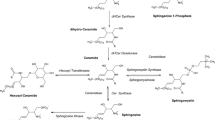Abstract
Lysophospholipids (LPLs) are an essential family of lipids, which serve as bioactive molecules and as precursors and intermediates of the glycerophospholipid and sphingolipid metabolisms. In this work we primarily focused on the subgroup lysoglycerophospholipids that comprise a polar headgroup at the sn-3 position and a fatty acyl group at either the sn-1 or sn-2 position of the glycerol backbone giving rise to the two potential regioisomers 1-acyl-2-LPL and 2-acyl-1-LPL, respectively. We established a quantitative lysophospholipidomics method combining hydrophilic interaction chromatography (HILIC) with the scheduled multiple reaction monitoring (sMRM) algorithm for profiling a vast number of LPLs simultaneously, including the 1-acyl-2-LPL and 2-acyl-1-LPL regioisomers. This approach facilitates baseline separation of monitored lipid classes and regioisomers, including sufficient separation of species having a different degree of unsaturation overcoming the overlapping effect of M + 2 isotopes. The lipid class-based separation improves the quantification of each molecular species as the internal standard elutes together with the endogenous species. The potential of this method is illustrated by analyzing LPLs from human plasma and skin samples. Altogether, 68 molecular lipid species, consisting of 110 regioisomers, were detected in plasma and 43 molecular lipids, consisting of 67 regioisomers, in skin samples. The novel skin LPL profile reveals that most of the lipid species exist as 2-acyl-1-LPL, in comparison to plasma where 1-acyl-2-LPLs are the dominant species.

Quantitative lysophospholipidomics






Similar content being viewed by others
References
van Meer G (2005) Cellular lipidomics. EMBO J 24:3159–3165
Ekroos K (2012) In: Ekroos K (ed) Lipidomics, technologies and applications. Wiley-VCH, Weinheim
Jung HR, Sylvanne T, Koistinen KM, Tarasov K, Kauhanen D, Ekroos K (2011) High throughput quantitative molecular lipidomics. Biochim Biophys Acta 1811:925–934
Grzelczyk A, Gendaszewska-Darmach E (2013) Novel bioactive glycerol-based lysophospholipids: new data–new insight into their function. Biochimie 95:667–679
Nixon GF, Mathieson FA, Hunter I (2008) The multi-functional role of sphingosylphoshorylcholine. Prog Lipid Res 47:62–75
Tigyi G, Parrill AL (2003) Molecular mechanisms of lysophosphatidic action. Prog Lipid Res 42:498–526
Lísa M, Cífková E, Holčapek M (2011) Lipidomic profiling of biological tissues using off-line two-dimensional high-performance liquid chromatography-mass spectrometry. J Chromatogr A 1218:5146–5156
Lee JY, Min HK, Moon MH (2011) Simultaneous profiling of lysophospholipids and lysophospholipids from human plasma by nanoflow liquid chromatography-tandem mass spectrometry. Anal Bioanal Chem 400:2953–2961
Okudaira M, Inoue A, Shuto A, Nakanaga K, Kano K, Makide K, Saigusa D, Tomioka Y, Aoki J (2014) Separation and quantification of 2-acyl-1-lysophospholipids and 1-acyl-2-lysophospholipids in biological samples by LC-MS/MS. J Lipid Res 55:2178–2192
Baker DL, Desiderio DM, Miller DD, Tolley B, Tigyi GJ (2001) Direct quantitative analysis of lysophosphatidic acid molecular species by stable isotope dilution electrospray ionization liquid chromatography-mass spectrometry. Anal Biochem 292:287–295
ICH Expert Working Group (2005) International conference on harmonization of technical requirements for registration of pharmaceuticals for human use, topic Q2 (R1). Validation of analytical procedures: text and methodology. ICH, Geneva
Scherer M, Schmitz G, Liebisch G (2009) High-throughput analysis of sphingosine 1-phosphate, sphinganine 1-phosphate, and lysophosphatidic acid in plasma samples by liquid chromatography-tandem mass spectrometry. Clin Chem 55:1218–1222
Lands WEM, Merkl I (1963) Metabolism of glycerolipids. III. Reactivity of various acyl esters of coenzyme A with α′-acylglycerol phosphorylcholine and positional specificities in lecithin synthesis. J Biol Chem 238:898–904
Ståhlman M, Ejsing CS, Tarasov K, Perman J, Borén J, Ekroos K (2009) High-throughput shotgun lipidomics by quadrupole time-of-flight mass spectrometry. J Chromatogr B 877:2664–2672
Lintonen TP, Baker PR, Suoniemi M, Ubhi BK, Koistinen KM, Duchoslav E, Campbell JL, Ekroos K (2014) Differential mobility spectrometry-driven shotgun lipidomics. Anal Chem 86:9662–9669
Acknowledgments
We thank all members of our laboratory for valuable discussions and suggestions, and the Finnish Funding Agency for Technology and Innovation (Tekes) for financial support.
Author information
Authors and Affiliations
Corresponding author
Additional information
Published in the topical collection Lipidomics with guest editor Michal Holčapek.
Rights and permissions
About this article
Cite this article
Koistinen, K.M., Suoniemi, M., Simolin, H. et al. Quantitative lysophospholipidomics in human plasma and skin by LC–MS/MS. Anal Bioanal Chem 407, 5091–5099 (2015). https://doi.org/10.1007/s00216-014-8453-9
Received:
Revised:
Accepted:
Published:
Issue Date:
DOI: https://doi.org/10.1007/s00216-014-8453-9




